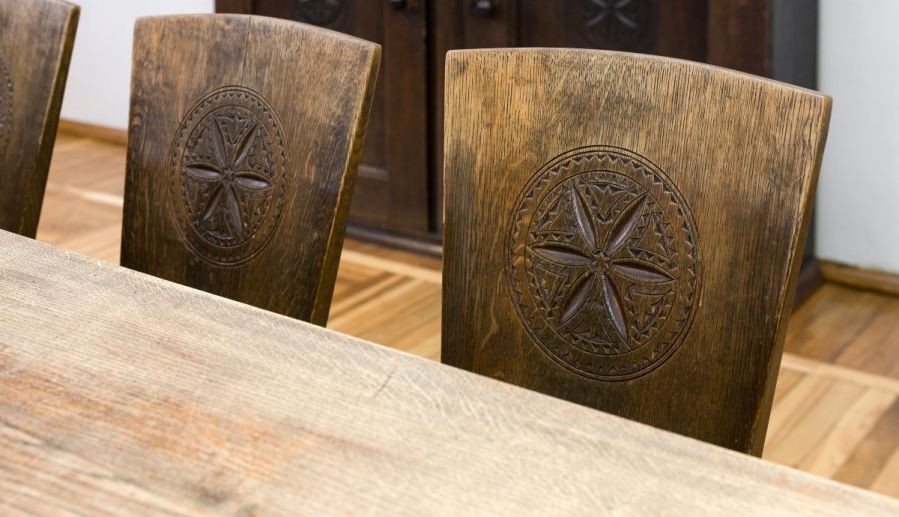Woodworking encompassed both decorative art as well as furniture. The demand for furniture was particularly high given the increase in the scope and plans for construction. Consumer furniture in the 1950s and 1960s was produced by furniture and woodworking workshops and furniture factories operating in every larger Lithuanian city. The style of mass-produced furniture was designed to meet the aesthetic standards of the era, with designers equating modern style with a laconic appearance, new and cheaper technologies, and the convenience associated with functionalism. Furniture was meant to be rational in construction, portable, made from inexpensive and local materials, and preferably was to be assembled from uniform parts that suited a typical residential style. Ornamentation was almost never used, because the very construction of a piece of furniture and its shape was considered to have its own, inherent aesthetic value.
Who were the furniture designers of this period? Immediately after the war, the Decorative Architecture Department of the Kaunas State Institute for Applied and Decorative Arts trained specialists in interior furnishing (as well as garden and park planners), however it produced only a small number of graduates during its short-lived existence (from 1947 to 1951). From 1951 onward, as part of the newly established Lithuanian Art Institute, the Architecture Planning and Composition Department trained multidisciplinary artist-architects in furniture and interior design.
In 1957, the Furniture Design and Assembly Bureau was opened in Vilnius to encourage development of modern interior styles. The agency primarily produced standardized furniture templates for the entire Lithuanian furniture industry, but it also developed unique furniture designs for official and public interiors. Stylish designs were created by architects and artists employed by the Bureau, including Brigita Adomonienė (b. 1931), Tadas Baginskas (b. 1936), Vytautas Beiga (b. 1928), Valerija Cukermanienė (b. 1936), Eugenijus Cukermanas (b. 1935), Eugenijus Gūzas (b. 1939), Lygija Stapulionienė (b. 1928), Algimantas Stapulionis (1924–1999), and Liucija Zaveckienė (b. 1929), as well as specialists unaffiliated with the Bureau such as Jonas Virakas (1905–1988), Simonas Ramunis (1916–2002), Algimantas Nasvytis (b. 1928), Vytautas Nasvytis (b. 1928), and Sofija Rimantienė (b. 1921). Furniture manufactured according to designs by these and other architects and artists were displayed at Lithuanian applied arts exhibitions as well as Soviet furniture and interior design shows. Lithuanians were often commissioned to design furniture for Soviet diplomatic offices abroad.
Unique furniture pieces were more of a rarity. In a time of nearly universal shortages (popularly known as "deficits"), there were few sponsors able to afford custom-made furniture. Moreover, appreciation of originality in interior design was a rare commodity. “Have you thrown away that old furniture set yet?” the architect Algimantas Nasvytis once asked Juozas Balčikonis in the early 1960s, referring to a collection of Neo Rococo furniture pieces and a table made in the famous French Boulle style, adorned with brass and tortoise shell inlay, acquired after the war by the famous textile artist's family. Balčikonis never replaced the historic pieces with anything new—they remained with him for his entire life. The textile artist never missed an opportunity to tell his guests how the famous architect once advised him to get rid of the old things. Balčikonis also enjoyed modern design, however, and his apartment found a place for a custom-made furniture set he commissioned from Jonas Prapuolenis in the 1960s.
Jonas Prapuolenis (1900–1980) was one of only a few designers of custom furniture who continued to faithfully promote a unique Lithuanian style during a period dominated by cosmopolitan functionalism. Prapuolenis created furniture for various purposes (over 150 sets in total) for public offices, designing and producing the pieces himself, while at the same time adapting to the prevailing circumstances of the day by also crafting designs for mass production.
The appearance of Prapuolenis' furniture pieces was determined by their function: public office furniture was heavier and bulkier (as in the set made in 1940 for the Teachers' Room of the Kaunas School of Art, now on display in the Office of the Rector of the Vilnius Academy of Arts, or in furniture designed for the Lithuanian Artists' Union in 1954), while residential interior pieces were lighter and more modest, such as his bedroom set entitled Žvaigždutė (Little Star), designed in 1956, or a living room set he created in 1959. He also chose his wood to match the intended function: dark oak for offices and official interiors; lighter maple, birch and elm for living rooms and bedrooms; and pine, spruce or linden for summer cottages. A Lithuanian flavor was given to his furniture through the use of construction features reminiscent of folk art woodworking (in the use of certain joinery techniques or backrests shaped to resemble traditional folk chairs, for example) and folk decorative motifs (intarsia and incised openwork featuring spindles and sun motifs). Prapuolenis' furniture pieces were comfortable, laconic, memorable, and unassumingly adorned with traditional folk decor.
As functionalist trends increasingly took hold, Prapuolenis embraced a simplicity of form. The furniture pieces he designed in the 1960s were refined, elegant, unassuming, made primarily of light-colored wood, and almost completely devoid of any ornamentation (as in his sitting-room furniture from 1964, or a furniture set for a child's room, made in 1969). Certain elements, such as the construction of a table or chair, their overall proportions and outlines, linked the pieces with traditional folk predecessors.
The Lithuanian national style of Prapuolenis' furniture impressed interior designers in Moscow, who took note of the artists' rural background and the fact that he never had to learn about his national roots from books or museum halls, since “his entire life was tied to the people”, having witnessed the “simple country life” since childhood. Soviet specialists viewed Lithuanian furniture pieces as examples of how to be modern without losing touch with one's national roots.




Comments
Write a comment